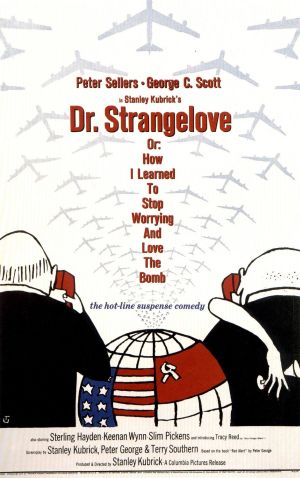 Released in 1963, Dr. Strangelove (Or How I Learned to Stop Worrying and Love the Bomb), directed by master filmmaker Stanley Kubrick, has not lost an iota of its impact. A satire of nuclear-armed Cold War paranoia, the film has managed to remain relevant in its criticism of the mechanical bureaucracies that undermine our safety.
Released in 1963, Dr. Strangelove (Or How I Learned to Stop Worrying and Love the Bomb), directed by master filmmaker Stanley Kubrick, has not lost an iota of its impact. A satire of nuclear-armed Cold War paranoia, the film has managed to remain relevant in its criticism of the mechanical bureaucracies that undermine our safety.
Oh and it’s a pretty funny movie too.
Set at the height of the Cold War with East-West rivalry at an apex, the story begins when a mad American general, morbidly named Jack D. Ripper, orders his bombers on an all-out attack on the Soviet Union. He does so to force the hand of his government because if they can’t recall the planes then they’ll have to commit everything to avoid getting struck by a Soviet nuclear counterattack.
For those unversed in Cold War nuclear strategy, this was the de-facto policy known as MAD or mutually assured destruction, which was practiced by both sides during this time. The film is basically a parody of the mindsets that were in charge. This all can sound pretty technical, but is handled deftly as we are focused on the characters attempts to come to grips with this dire situation.
And what an array of characters there are, from the constantly flabbergasted British officer who tries to get his boss to recall the attack, to the stone-faced President trying to stop nuclear war and to the ex-Nazi advisor who can just barely restrain his glee. It also bears to mention that all three of these characters are played by the same actor, Peter Sellers, who is on top of his game here, anchoring the film. Each of the personas he inhabits is quite different and it wouldn’t be surprising if a casual viewer didn’t get the distinction.
Also doing a great job is George C. Scott playing a comedic role as a general advising the President who sees the circumstances as a chance to hand it to the Russkies. Scott famously complained that Kubrick only used the takes of him overacting and vowed never to work with him again. However, he eventually grew to be proud of it, which he should be as he lights up the screen whenever he’s on.
Other performances worth noting include Sterling Hayden as the mad John Birch inspired general that launches the attack. In several close-ups you can just see the menace coming out of his pores. On the other end of the spectrum is Slim Pickens, playing the commander of the B-52 bomber that is leading the assault. Every scene he’s in is just comically explosive as he exhorts his crew in a thick Southern drawl while donning a cowboy hat that he had kept in a safe. Dr. Strangelove is also James Earl Jones’ first movie; he’s one of the crewmen of the B-52.
A lot of what makes this film a classic can be put on the shoulders of Kubrick himself, who also produced and co-wrote it. His influence is all over the picture. Coming out at a time when the events discussed were a very real possibility, the film was originally intended to have a more serious tone. However, some late night tinkering by Kubrick led to the film adopting a comedic tone. He was also on the cutting edge of filmmaking at the time, using hand-held photography to shoot several war scenes, lending them an air of gritty realism.
Speaking of realism, the production values of this film are top-notch. Specifically the sets for the war room where the President and his advisors yell at each other and the interior of the B-52 bomber that is leading the attack. In fact the latter set was so well made that Air Force personnel who came to look at it called it a perfect copy, even though the production designers received no help from the government.
Despite the end of the Cold War, the threat of nuclear weapons is still with us. Because of this, Dr. Strangelove remains as timely as ever. It artfully balances serious themes like oh say, thermonuclear Armageddon, with the humor of the American President trying to tell his drunken Soviet counterpart as nicely as possible over the phone that a million tons of firepower is on its way to his country. Also, the image of a cowboy riding a nuclear bomb down to its target never gets old.

Leave a Reply